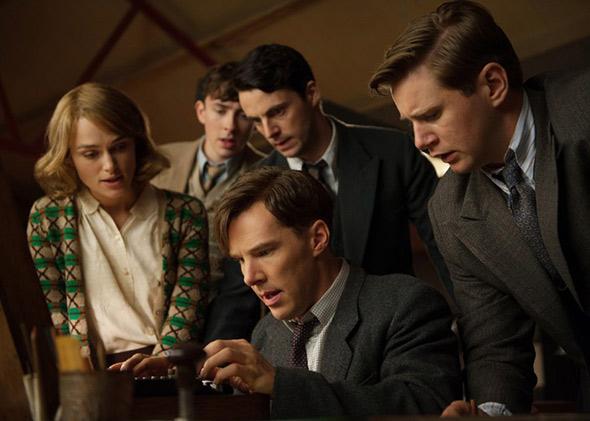The Oscar-buzzed new movie The Imitation Game is an old-fashioned biopic, crafting a tidy, entertaining narrative from disparate strands of its subject’s life—in this case, British mathematician, codebreaker, and computer pioneer Alan Turing. Slate movie critic Dana Stevens has taken issue with the film’s emotional straightforwardness, writing, “The Imitation Game doesn’t do right by the complex and often unlovable man it purports to be about.” Meanwhile, on Outward, my colleagues J. Bryan Lowder and June Thomas praise the film’s message in spite of its historical inaccuracies.
Just how inaccurate are those inaccuracies? I read the masterful biography that the screenplay is based on, Andrew Hodges’ Alan Turing: The Enigma, to find out. I discovered that The Imitation Game takes major liberties with its source material, injecting conflict where none existed, inventing entirely fictional characters, rearranging the chronology of events, and misrepresenting the very nature of Turing’s work at Bletchley Park. At the same time, the film might paint Turing as being more unlovable than he actually was. For details on the film’s flights of fancy, read on. (There will, naturally, be spoilers.)
Alan Turing (Benedict Cumberbatch)
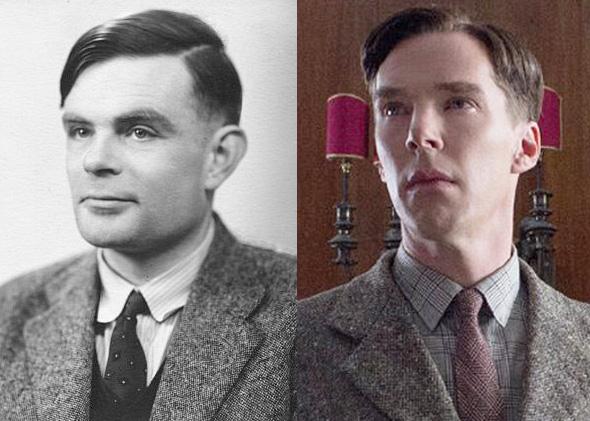
Wikimedia Commons / © 2014 - The Weinstein Company
The Alan Turing played by Benedict Cumberbatch is brusque, humorless, and brilliant. In an early scene where he is interviewed by Commander Denniston (Charles Dance), we learn that he made exceptional achievements in mathematics at a young age. This is a reflection of reality: Turing was elected as a fellow at Cambridge at the age of 22, and he published his most influential paper, “On Computable Numbers,” at 24.
Other aspects of Cumberbatch’s characterization are true to life, as well: Turing was fairly indifferent to politics, both in the interpersonal sense and in the civic sense. He ran marathons. He was also gay, and even more openly than the film implies. Hodges’ biography is filled with instances in which Turing boldly made advances toward other men—mostly without success. Turing also told his friends and colleagues about his homosexuality.
However, the central conceit of The Imitation Game—that Turing singlehandedly invented and physically built the machine that broke the Germans’ Enigma code—is simply untrue. A predecessor of the “Bombe”—the name given to the large, ticking machine that used rotors to test different letter combinations—was invented by Polish cryptanalysts before Turing even began working as a cryptologist for the British government.* Turing’s great innovation was to design a new machine that broke the Enigma code faster by looking for likely letter combinations and ruling out combinations that were unlikely to yield results. Turing didn’t develop the new, improved machine by dint of his own singular genius—the mathematician Gordon Welchman, who is not even mentioned in the film, collaborated with Turing on the design.
Leaving aside Turing’s codebreaking achievements, The Imitation Game also somewhat alters Turing’s personality. The film strongly implies that Alan is somewhere on the autism spectrum: Cumberbatch’s character doesn’t understand jokes, takes common expressions literally, and seems indifferent to the suffering and annoyance he causes in others. This characterization is rooted in Hodge’s biography but is also largely exaggerated: Hodges never suggests that Turing was autistic, and though he refers to Turing’s tendency to take contracts and other bureaucratic red tape literally, he also describes Turing as a man with a keen sense of humor and close friends. To be sure, Hodges paints Turing as shy, eccentric, and impatient with irrationality, but Cumberbatch’s narcissistic, detached Alan has more in common with the actor’s title character in Sherlock than with the Turing of Hodges’ biography. One of Turing’s colleagues at Bletchley Park later recalled him as “a very easily approachable man” and said “we were very very fond of him”; none of this is reflected in the film.
In addition to the more significant creative liberties that the movie takes, there are small fictions surrounding his character in the movie. Although, in the movie, Alan tells Denniston that he doesn’t know German, Turing did in fact study German and travel to Germany before and after the war. Turing did not, as far as we know, have a compulsion to separate his peas and carrots. (In fact, given his generally unkempt appearance, it’s highly unlikely he gave attention to such details.) And whether or not Turing liked sandwiches—a key plot point in The Imitation Game—goes unmentioned in Hodges’ biography.
Christopher Morcom (Jack Bannon)
In flashbacks to 1928 in The Imitation Game, we learn that Alan’s first love was a classmate at boarding school named Christopher. Christopher rescues Alan after he’s nailed under the floorboards by bullies, teaches Alan to communicate via codes and ciphers, flirts with Alan, and then suddenly dies of bovine tuberculosis.
Although many of the details are invented for the movie, the gist of this storyline is true: Turing really did befriend and develop romantic feelings for a boy named Christopher Morcom at Sherborne School, the boys’ school in Dorset that he attended as a teenager. (He also did get trapped under the floorboards by other boys, according to Alan Turing: The Enigma, but this occurred before he met Morcom.) Morcom died from bovine tuberculosis in 1930, shortly after he’d been accepted to Cambridge and three years after Turing had first met him.
In the movie, it’s implied that Christopher shares Alan’s attraction, but it seems likely that Turing’s affection for Morcom was unrequited—Turing later wrote, “Chris knew I think so well how I liked him, but hated me shewing it.” Several other details of their relationship are different in the movie than in Alan Turing: The Enigma. Although in the movie Christopher is taller than young Alan (Alex Lawther), in reality Turing had a growth spurt at 15, while Morcom was “surprisingly small for his form.” (Morcom was one year ahead of Turing in school.) Turing and Morcom bonded over math and chemistry, not ciphers; Turing began exploring ciphers with another friend at Sherborne after Morcom had died. The biggest departure from reality in the film is the scene where the headmaster informs Alan of Christopher’s death, and Alan denies having known Christopher very well. In real life, Turing was openly devastated by Morcom’s death, and he subsequently developed a relationship with Morcom’s family, going on vacations with them and maintaining a correspondence with Morcom’s mother for years after he’d left Sherborne.
Additionally, Turing did not call any of the early computers he worked on “Christopher”—that is a dramatic flourish invented by screenwriter Graham Moore.
Commander Denniston (Charles Dance)
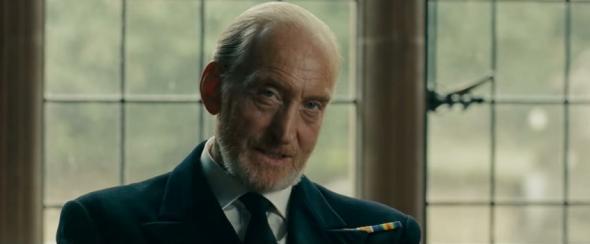
Screenshot © 2014 - The Weinstein Company
In The Imitation Game, Commander Denniston is a rigid naval officer who resents Alan’s indifference to the military hierarchy and attempts to fire him when his decryption machine fails to deliver fast results. This characterization is mostly fictional, and Denniston’s family has taken issue with the film’s negative portrayal of him. The real-life Alastair Denniston, who spent most of his career as the director of the Government Code and Cypher School, was eager to expand his staff to help break the Germans’ Enigma code in the late 1930s. He recruited Turing, on the basis of his work at Cambridge and his writing on hypothetical computation machines, in 1938, and he hired Turing to work full time at Bletchley Park when Britain entered World War II in September 1939. There’s no record of a contentious interview between Turing and Denniston, and Denniston never tried to fire Turing from the Government Code and Cypher School—rather, given his innovations, Turing was a star of Bletchley Park.
Even if most of the details of the conflict between Commander Denniston and Alan are made up, they do stand in for a real-life power struggle between the military brass and the cryptologists. Turing’s colleagues there recalled that Turing “was always impatient of pompousness or officialdom of any kind,” which made him ill-suited for work in a military context, and Hodges writes that he “had little time for Denniston.” One of the most memorable clashes between Commander Denniston and Alan in the movie occurs when Alan goes over Denniston’s head to write a letter to Winston Churchill, who immediately puts Alan in charge of the Enigma-breaking operation and grants him the 100,000 pounds he needs to build his machine. This never happened, but Alan and three colleagues at Bletchley Park—including Hugh Alexander—did write a letter to Churchill requesting more staff and resources in 1941, and Churchill quickly granted them their requests.
Hugh Alexander (Matthew Goode)
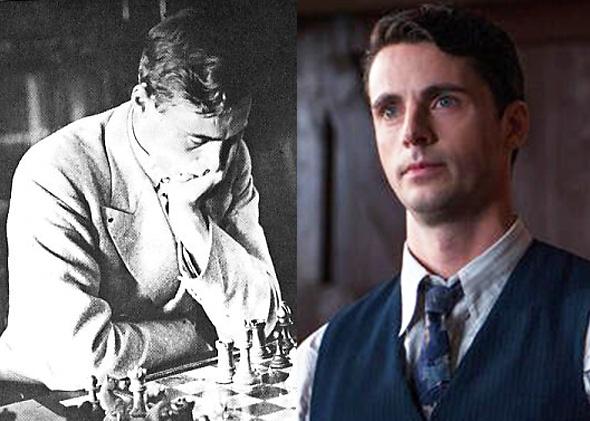
Wikimedia Commons / © 2014 - The Weinstein Company
In The Imitation Game, Hugh Alexander is a suave ladykiller who spends much of the film battling with Alan for control of the codebreaking operations; Hugh eventually recognizes Alan’s genius and falls in line behind him. Hugh Alexander—who went professionally by Conel Hugh O’Donel Alexander or C.H.O’D. Alexander—was a real person, but the film’s Hugh character seems intended to serve as a contrast to Alan’s antisocial personality.
The film is faithful to the basic facts: Alexander was a chess champion, and he was much better at managing people than Turing was. However, Alexander was not initially assigned to be Turing’s superior at Bletchley Park. Alexander began working there several months after Turing arrived, and the two didn’t begin working together for another year or so, when Alexander was transferred to Turing’s team to work on breaking Germany’s naval Enigma code. Hodges writes, “Hugh Alexander soon proved the all-round organiser and diplomat that Alan could never be.” Alexander eventually took over naval Enigma decryption after Turing began pursuing a speech decryption project, but by all accounts, their relationship was friendly and mutually respectful. In fact, when Turing was tried for indecency in 1952, Alexander served as a character witness for the defense.
Joan Clarke (Keira Knightley)
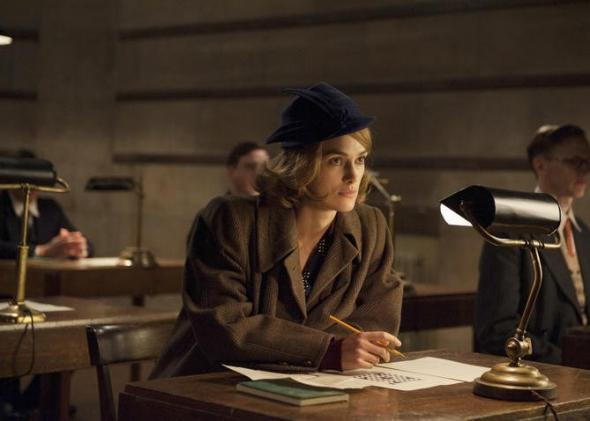
© 2014 - The Weinstein Company
Keira Knightley’s character in The Imitation Game is a brilliant, spunky young mathematician whom Alan agrees to marry to get her conservative parents off her back. As with other storylines, the skeleton of this narrative is true, even if the details are not. Clarke was recruited to Bletchley Park by her former academic supervisor (and Turing’s partner in improving the Bombe) Gordon Welchman; she didn’t win the role by excelling in a crossword competition. (Bletchley recruiters did use crosswords to find talented codebreakers, but neither Turing nor Clarke was involved in this effort.) And Turing proposed to Clarke not to help her escape from overbearing parents, but because they liked each other. He “told her that he was glad he could talk to her ‘as to a man,’ ” writes Hodges, and they shared an interest in chess and botany. She even accepted Turing’s homosexuality; their engagement continued after he confessed his attraction to men. But after some months, Turing ended the engagement. “It was neither a happy nor an easy decision,” writes Hodges, but it wasn’t the ultimately violent confrontation depicted in The Imitation Game, either. “There had been several times when he had come out with ‘I do love you.’ Lack of love was not Alan’s problem.”
Turing and Clarke kept in touch after their engagement ended, and Turing even tried to rekindle their relationship after a couple of years, but Clarke rebuffed him. Turing also wrote a letter to Clarke in 1952 to inform her of his impending trial for indecency, but the final scene of The Imitation Game, in which Joan visits Alan during his probation, is invented.
Stewart Menzies (Mark Strong) and John Cairncross (Allen Leech)
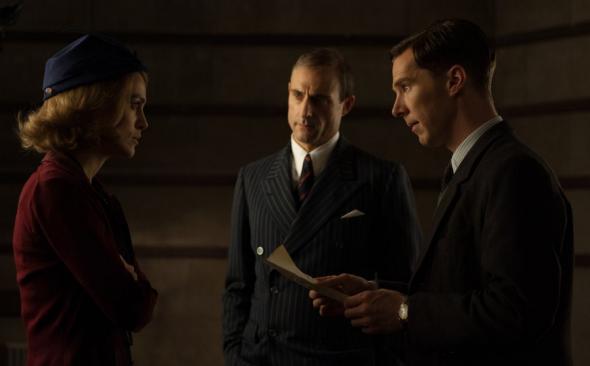
© 2014 - The Weinstein Company
Stewart Menzies, the chief of the British Secret Intelligence Service, and John Cairncross, a Soviet spy, are two historical figures who appear in The Imitation Game despite the fact that neither worked closely with Turing. Menzies was, as the film suggests, responsible for passing decrypted Nazi strategies to Winston Churchill, but it’s highly unlikely he interacted individually with Turing (or most of the thousands of other codebreakers who worked at Bletchley Park over the years). Cairncross did pass intelligence from Bletchley Park to the Soviet Union, but he worked in a different unit from Turing’s, and there’s no evidence the two knew each other. Similarly, the filmmakers’ conceit that Menzies knew about and tolerated Cairncross’ duplicity isn’t supported by the historical record.
Peter Hilton (Matthew Beard) and Jack Good (James Northcote)
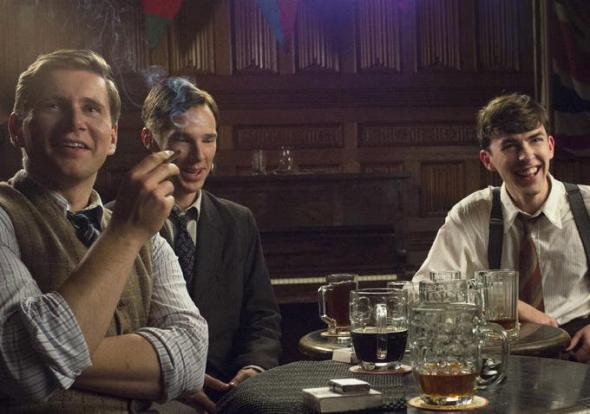
© 2014 - The Weinstein Company
In the film, Peter and Jack are more or less interchangeable background characters, distinguished primarily by the fact that Peter has a brother who is serving in the armed forces on a ship that the code-breaking team discover is targeted by the Germans. The ensuing dramatic scene, in which Alan reminds Peter and the rest of the team that they have to keep the Germans from learning that they’ve broken Enigma, is entirely invented; Hilton had no such brother, and in fact he began working at Bletchley Park long after Turing’s Bombe had been built. And while it was crucial for the British to use their intelligence wisely, Hodges writes that their success had less to do with their tactical shrewdness and more to do with the Germans’ a priori conviction that Enigma was unbreakable, despite ample evidence to the contrary.
Detective Nock
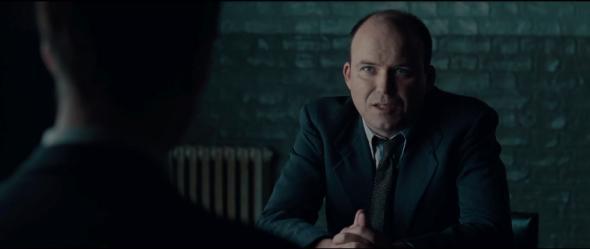
Screenshot © 2014 - The Weinstein Company
The Imitation Game’s framing device depicts one Detective Nock’s investigation into Alan’s life, following a mysterious burglary at Alan’s home. Perhaps unsurprisingly, this framing device isn’t quite true to life: There was no Detective Nock, and the detectives who did book Turing for indecency (who were named Mr. Wills and Mr. Rimmer) were under no illusions about his mysterious circumstances. Turing was burglarized by an acquaintance of 19-year-old Arnold Murray, who had slept with Turing a few times. The burglar had heard Murray talk about his trysts with Turing, and when the police interrogated the burglar, he revealed the illicit nature of Murray and Turing’s relationship. When the police interviewed Turing, he made no attempt to hide his homosexuality from them. Turing eventually pled guilty to indecency, and he was placed on probation and agreed to submit to estrogen treatment—intended to destroy his sex drive—for more than a year.
The Imitation Game implies that the estrogen treatment sent Alan into an emotional tailspin, but Turing seems to have continued his work and social relationships normally during his year of probation. The film also implies that the estrogen treatment triggered Alan’s suicide, but in fact the treatment ended in April 1953, fourteen months before Turing killed himself. Although some modern scholars believe that his death from cyanide poisoning was an accident, Hodges believes that Turing made his suicide deliberately ambiguous so as to spare his mother the pain of believing that her son had killed himself on purpose.
Correction, Jan. 28, 2015: This post originally misstated that Polish cryptanalysts built “the first version of the ‘Bombe.’ ” Though it did crack the Germans’ code and influence Turing and his colleagues, the Polish Bomba was mechanically different from the British “Bombe.”
Previously
How Accurate Is The Theory of Everything?
How Accurate Is Foxcatcher?
How Accurate Is Jersey Boys?
How Accurate Is Get on Up?
